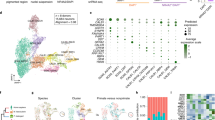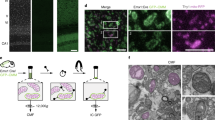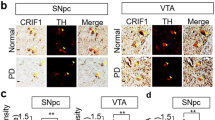Abstract
Using a novel single-molecule PCR approach to quantify the total burden of mitochondrial DNA (mtDNA) molecules with deletions, we show that a high proportion of individual pigmented neurons in the aged human substantia nigra contain very high levels of mtDNA deletions. Molecules with deletions are largely clonal within each neuron; that is, they originate from a single deleted mtDNA molecule that has expanded clonally. The fraction of mtDNA deletions is significantly higher in cytochrome c oxidase (COX)-deficient neurons than in COX-positive neurons, suggesting that mtDNA deletions may be directly responsible for impaired cellular respiration.
This is a preview of subscription content, access via your institution
Access options
Subscribe to this journal
Receive 12 print issues and online access
$209.00 per year
only $17.42 per issue
Buy this article
- Purchase on Springer Link
- Instant access to full article PDF
Prices may be subject to local taxes which are calculated during checkout


Similar content being viewed by others
References
Harman, D. J. Am. Geriatr. Soc. 20, 145–147 (1972).
Linnane, A.W., Marzuki, S., Ozawa, T. & Tanaka, M. Lancet 1, 642–645 (1989).
Khrapko, K., Kraytsberg, Y., de Grey, A., Vijg, J. & Schon, E.A. Aging Cell (in the press).
Jacobs, H.T. Aging Cell 2, 11–17 (2003).
Corral-Debrinski, M. et al. Nat. Genet. 2, 324–329 (1992).
Soong, N.W., Hinton, D.R., Cortopassi, G. & Arnheim, N. Nat. Genet. 2, 318–323 (1992).
Itoh, K., Weis, S., Mehraein, P. & Muller-Hocker, J. Neurobiol. Aging 17, 843–848 (1996).
Nekhaeva, E., Kraytsberg, Y. & Khrapko, K. Mech. Ageing Dev. 123, 891–898 (2002).
Kraytsberg, Y. & Khrapko, K. Expert Rev. Mol. Diagn. 5, 809–815 (2005).
Rossignol, R. et al. Biochem. J. 370, 751–762 (2003).
Bender, A. et al. Nat. Genet., advance online publication 9 April 2006 (doi:10.1038/ng1769).
Khrapko, K. et al. Nucleic Acids Res. 27, 2434–2441 (1999).
Bennett, D.A. et al. N. Engl. J. Med. 334, 71–76 (1996).
Ross, G.W. et al. Ann. Neurol. 56, 532–539 (2004).
Khrapko, K. Rejuvenation Res. 8, 6–8 (2005).
Acknowledgements
The authors are grateful to A. Griner, A. Kraytsberg, and A. Vaysburd for help in experiments; E. Richfield (Rutgers University) for tissue samples and critical review of the manuscript; W. Kunz for communicating his histochemistry protocols and O. Kocher (Beth Israel Deaconess Medical Center) for granting access to a laser capture microscope. This work was supported in part by US National Institutes of Health grants ES11343 and AG19787 to K.K. and AG13846 (Boston University Alzheimer Disease Center) to N.W.K. and the Department of Veteran Affairs.
Author information
Authors and Affiliations
Corresponding author
Ethics declarations
Competing interests
The authors declare no competing financial interests.
Supplementary information
Rights and permissions
About this article
Cite this article
Kraytsberg, Y., Kudryavtseva, E., McKee, A. et al. Mitochondrial DNA deletions are abundant and cause functional impairment in aged human substantia nigra neurons. Nat Genet 38, 518–520 (2006). https://doi.org/10.1038/ng1778
Received:
Accepted:
Published:
Issue Date:
DOI: https://doi.org/10.1038/ng1778
This article is cited by
-
Application of left ventricular endomyocardial biopsy in the diagnosis of mitochondrial cardiomyopathy: a case report
BMC Cardiovascular Disorders (2023)
-
Mechanisms Underlying Brain Aging Under Normal and Pathological Conditions
Neuroscience Bulletin (2023)
-
The use of fibroblasts as a valuable strategy for studying mitochondrial impairment in neurological disorders
Translational Neurodegeneration (2022)
-
Mitochondrial biogenesis, telomere length and cellular senescence in Parkinson’s disease and Lewy body dementia
Scientific Reports (2022)
-
Carrying Excess Baggage Can Slowdown Life: Protein Clearance Machineries That Go Awry During Aging and the Relevance of Maintaining Them
Molecular Neurobiology (2022)



